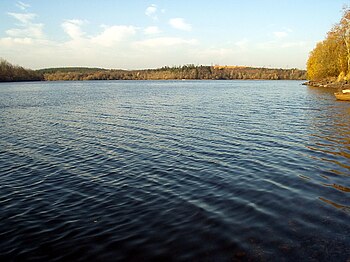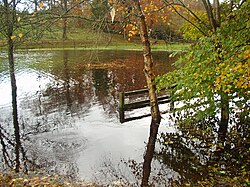Lough Oughter: Difference between revisions
No edit summary |
|||
| Line 26: | Line 26: | ||
==Outside links== | ==Outside links== | ||
{{commons}} | |||
*[http://www.birdwatchireland.ie Bird Watch Ireland] | *[http://www.birdwatchireland.ie Bird Watch Ireland] | ||
*[http://www.npws.ie National Parks and Wildlife Service] | *[http://www.npws.ie National Parks and Wildlife Service] | ||
Latest revision as of 21:26, 10 February 2018

Lough Oughter (Irish: Loch Uachtair) is a lake, or complex of lakes, in County Cavan seven and a half miles long and covering approximately 22,070 acres. It is on the River Erne, and forms the southern part of the Lough Erne complex.
The lakes are bounded roughly by Belturbet in the north; Cavan Town to the east; Crossdoney to the south and Killeshandra to the west.
Scientific evaluations consider the Lough Oughter area as a whole as the best inland example of a flooded drumlin landscape in Ireland and has many rich and varied biological communities. Nowhere else in the country does such an intimate mixture of land and water occur over a comparable area, and many of the species of wetland plants, some considered quite commonplace in Lough Oughter and its associated lakes, are infrequent elsewhere. The number of whooper swans which winter in the area represents about 3% of the total European population while the lake also houses the largest concentration of breeding Great Crested Grebes in the Republic, having become almost extinct in the 19th century.
Lough Oughter has long been classed locally as an angling lake and is grossly under valued for its qualities as a potential venue for wildlife eco-tourism and education, is now designated as a suitable wetland for inclusion in the 'Ramsar List of Wetlands of International Importance'. Cavan County Council have stated: "It is recognized nationally and internationally as being of significant values not only for the country, but for humanity as a whole". The Lough Oughter complex along with Killykeen Forest Park are designated Natura 2000 habitats, 'Special Areas for Conservation' and 'Special Protection Areas' under EU legislation. Lough Oughter is part of the UNESCO Marble Arch Caves Global Geopark.
The main threats to the quality of the site, according to scientific sources, are water polluting such as run-off from fertiliser and slurry applications and sewage discharge which have raised the nutrient status of some lakes to hypertrophic. Increased afforestation has resulted in some loss of wetland habitat and also loss of some feeding ground for wintering birds such as Greenland White-fronted Geese.
Recreation and eco-tourism

The lake is being promoted as a destination for eco-tourism, drawing upon the natural beauty and wildlife of the Lough Oughter complex of lakes and wetlands.
Killykeen Forest Park nearby is managed by the forestry service, Coillte as a commercial forestry site which has long been recognised for its interesting history and all seasons recreational qualities, located just five miles from Cavan town it spreads both sides of the Lough Oughter system. The park is popular with angling visitors and favoured for its walking trails through the leafy glades and along the lake shores.
Historic Settlement

Lough Oughter is known too for the ancient monastic settlement on Trinity Island that once sustained a substantial resident native population around its shores back to the earliest times of settlement with several identified island, crannog locations and megalithic wedge tomb structures.
With the arrival of the English, the impressive Clogh Oughter Castle was built. It stands on a tiny island in Lough Oughter since the thirteenth century. It is circular in construction, some 50 feet in outside diameter and around 60 feet high. The nearest shore is approximately 142 yards away, close to the narrowest part of the lough at Inishconnell Rinn Point. Clogh Oughter Castle has been at the centre of much of County Cavan's turbulent history and was probably built originally to protect the Clan O'Reilly chieftains from their warring neighbours. During the seventeenth century, the castle changed hands several times and was one of the last defended castles to hold out during the Confederate Wars. Before this, Clogh Oughter Castle was used as a prison. Notably, the Bishop of Kilmore, William Bedell was held hostage here, and rebel leader Owen Rua O'Neil is reputed to have died here in 1649 and was secretly brought to Trinity Island for burial. The rebel army were finally defeated in 1653, after which the lofty walls of Clogh Oughter castle were breached by cannon shot and have remained unoccupied ever since, apart from nesting crows and water fowl.
During the late nineteenth century water levels on Lough Oughter were lowered to alleviate flooding of low lying farmland. However, plans are now afoot through Waterways Ireland to raise the levels again to facilitate tourism and allow pleasure boats to gain access into the lough from the River Erne right up to Killeshandra.
Outside links
| ("Wikimedia Commons" has material about Lough Oughter) |
